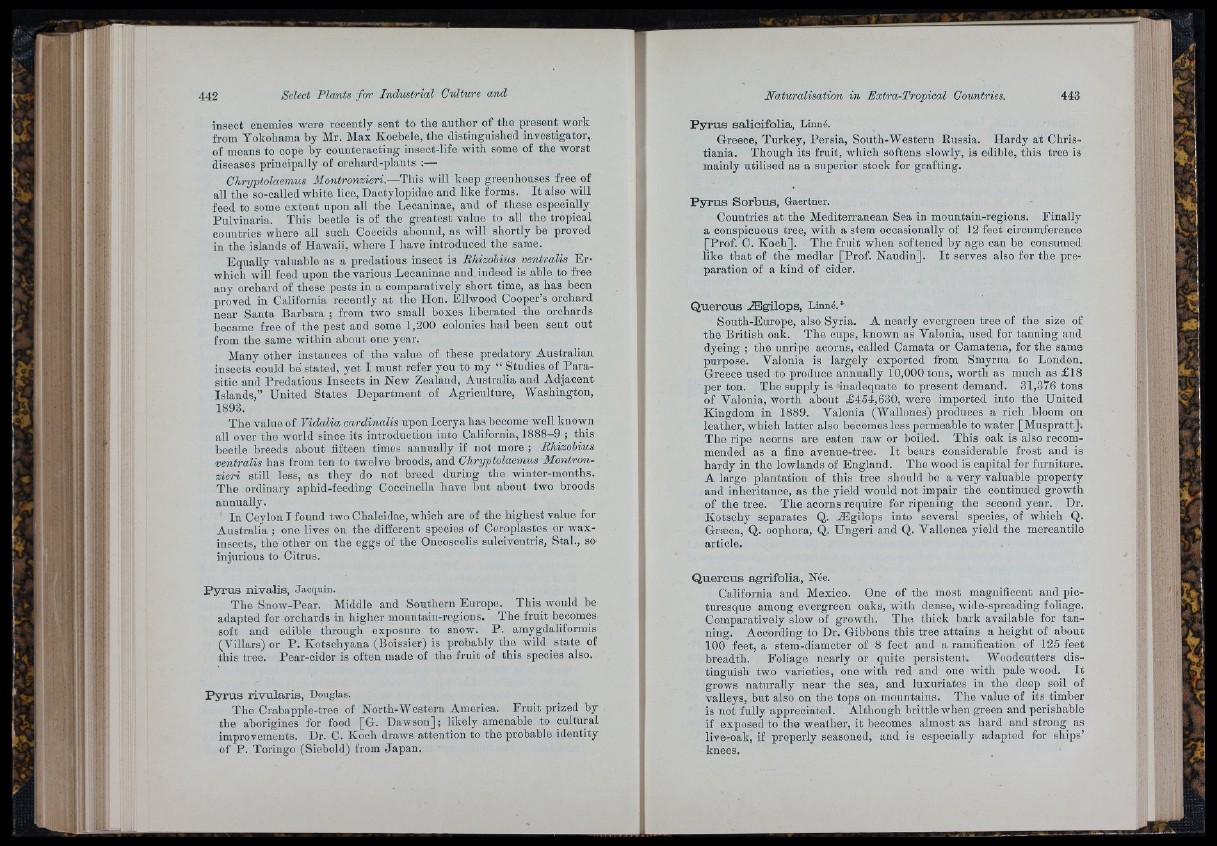
: Il
insect enemies were recently sent to the author of the present work
from Yokoliama by Mr. Max Koebele, the (listinguished investigator,,
of means to cope by counteracting insect-life with some of the worst
diseases priuoipally of orchard-plants :—■
Chryptolaemus Montronzieri.—^This will keep greenhouses free of
all the so-called white lice, Daotylopidae and like forms. I t also will
feed to some extent upon all the Lecaninae, arrd of these especially
Piilvinaria. Tliis beetle is of the greatest value to all the tropical
countries where all such Coccids abound, as will shortly be proved
in the islands of Hawaii, where I have introduced the same.
Equally valuable as a predatious insect is Rhizohius ventralis Er-
which will feed upon the various Lecaninae and indeed is able to free
any orchard of these pests in a comparatively short time, as has been
proved in California recently a t the Hon. Ellwood Cooper’s orchard
near Santa Barbara ; from two small boxes liberated the orchards
became free of the pest and some 1,200 colonies had been sent out
from the same within about one year.
Many other instances of the value of these predatory Australian
insects could be stated, yet I must refer you to my “ Studies of P a ra sitic
and Predatious Insects in New Zealand, Australia and Adjacent
Islands,” United States Department of Agriculture, Washington,
1893.
The valne of Vidalia cardinalis upon Icerya has become well known
all over the world since its introduction into California, 1888-9 ; this
beetle breeds about fifteen times annually if not more ; Rhizohius
ventralis has from ten to twelve broods, and Chryptolaemus Montron-
zieri still less, as they do not breed during the winter-months.
The ordinary aphid-feeding Coocinella have but abont two broods
annually.
In Ceylon I found two Chaleidae, which are of the highest value for
Australia ; one lives on the different species of Ceroplastes or wax-
insects, the other on the eggs of the Onooscelis sulciventris. Stab, so
injurious to Citrus.
Pyrus nivalis, Jacquin.
The Snow-Pear. Middle and Southern Europe. This would be
adapted for orchards in liigher moimtain-regious. The fruit becomes
soft and edible through exposure to snow. P . amygdaliformis
(Villars) or P . Kotsehyana (Boissier) is probably the wild state of
this tree. Pear-cider is often made of the fruit of this species also.
Pyrus rivularis, Douglas.
The Crabapple-tree of North-Western America. F ru it prized by
the aborigines for food [G. Dawson]; likely amenable to cultural
improvements. Dr. C. Koch draws attention to the probable identity
of P. Toringo (Siebold) from Jap an .
Pyrus salicifolia, Linné.
Greece, Turkey, Persia, South-Western Russia. Hardy at Christiania.
Though its fruit, which, softens slowly, is edible, this tree is
mainly utilised as a superior stock for grafting.
Pyrus Sorbus, Gaertner.
Countries a t the Mediterranean Sea in mountain-regions. Finally
a conspicuous tree, with a stem occasionally of 12 feet circumference
[P i’of. C. Koch]. The frnit when softened by age can be consumed
like th a t of the medlar [Prof. Naudin]. I t serves also for the preparation
of a kind of cider.
Quercus Æg-ilops, Linné.*
South-Europe, also Syria. A nearly evergreen tree of the size of
the British oak. The cups, known as Valonia, used for tanning and
dyeing ; the unripe acorns, called Camata or Camatena, for the same
purpose. Valonia is largely exported from Smyrna to London.
Greece used to produce annually 10,000 tons, worth as much as £18
per ton. The supply is inadequate to present demand. 31,376 tons
of Valonia, worth about £454,630, were imported into the United
Kingdom in 1889. Valonia (Wallones) produces a rich bloom on
leather, which latter also becomes less permeable to water [Muspratt].
The ripe acorns are eaten raw or boiled. This oak is also recommended
as a fine avenue-tree. I t bears considerable frost and is
hardy in the lowlands of England. The wood is capital for furniture.
A large plantation of this tree should be a very valuable property
and inheritance, as the yield would not impair the continued growth
of the tree. The acorns require for ripening the second year. Dr.
Kotschy separates Q. Ægilops into several species, of which Q.
Græca, Q. oophora, Q. Ungeri and Q. Vallonea yield the mercantile
article.
Quercus agrifolia, Née.
California and Mexico. One of the most magnificent and picturesque
among evergreen oaks, with dense, wide-spreading foliage.
Comparatively slow of growth. The thick bark available for tanning.
According to Dr. Gibbons this tree attains a height of about
100 feet, a stem-diameter of 8 feet and a ramification of 125 feet
breadth. Foliage nearly or quite persistent. Woodcutters distinguish
two varieties, one with red and one with pale wood. It
grows naturally near the sea, and luxuriates in the deep soil of
valleys, but also on the tops on monntains. The value of its timber
is not fully appreciated. Although brittle when green and perishable
if exposed to the weather, it becomes almost as hard and strong as
live-oak, if properly seasoned, and is especially adapted for ships’
knees.